Showing all 6 resultsSorted by latest
-

WWI & WWII Kreigsmarine Wehrpass & Marine Militärpass Matrosen Stolz – SMS Nassau – Battle of Riga – Battle of Jutland – Dog Tag WW2
$545.00Here we have a really interesting KM Grouping. This grouping comes with a Photo on board the SMS Nassau which is modelled in the below video really well: It seems he was called up in WWII and did a small service, for which his WWII KM Tag was added to his Wehrpass when he was discharged. Battle of Jutland
-

WWII German Soldbuch Cover – Nice not seen one (Sold)
A nice Soldbuch cover, it seems they had a patent pending for this cover and made these under the company called Koriko.
-

WWI German Soldbuch / Wehrpass WWII – Photos – Uffz Ledermann – 15 Landwehr Division – Fort Vaux – Crimea Ukraine – Iron Cross – Wounds Badge (Sold)
Eduard Ledermann Lived in Russian Czarist Empire – issued a Czarist ID Booklet. Incredible: Piotrków Governorate (Russian: Петроковская губерния; Polish: Gubernia piotrkowska) was one of the administrative divisions (guberniya; gubernia) in the Kingdom of Poland, established in 1867 by splitting some areas of the Radom and Warsaw Governorates. Its capital was in Petrokov (Russian: Петроко́в) in modern day Piotrków Trybunalski. Joined Landwehr Infanterie Regiment 53 – 15 Landwehr Division Iron Cross and Wounded by grenade splinters in Verdun 1916. Nice photos of Ledermann in uniform in WW1. The association was originally assembled as the Borries Division on January 9, 1915 on the Western Front and was statised on July 13, 1915 as the 15th Landwehr Division. She fought in the west until mid-March 1917 and was then transferred to the eastern front. After the armistice there, the division took part in the fighting in support of the Ukraine and did not return home until mid-March 1919 after the end of the war. Der Verband wurde ursprünglich als Division Borries am 9. Januar 1915 an der Westfront zusammengestellt und am 13. Juli 1915 als 15. Landwehr-Division etatisiert. Bis Mitte März 1917 kämpfte sie im Westen und wurde dann an die Ostfront verlegt. Nach dem dortigen Waffenstillstand war die Division an den Kämpfen zur Unterstützung der Ukraine beteiligt und kehrte nach Kriegsende erst bis Mitte März 1919 in die Heimat zurück. 1915 9. Januar bis 16. Oktober — Stellungskämpfe westlich Roye-Noyon ab 21. Oktober — Stellungskämpfe westlich Roye-Noyon 1916 Stellungskämpfe westlich Roye-Noyon 28. Januar bis 17. Februar — Kämpfe von Frise 1917 bis 15. März — Stellungskämpfe westlich Roye-Noyon 16. bis 19. März — Kämpfe vor der Siegfriedfront 20. bis 31. März — Transport nach dem Osten 1. April bis 7. Dezember — Stellungskrieg westlich Brody 7. bis 17. Dezember — Waffenruhe ab 17. Dezember — Waffenstillstand 1918 bis 18. Februar — Waffenstillstand 18. Februar bis 21. Juni — Kämpfe zur Unterstützung der Ukraine 16. bis 20. März — Gefechte bei Snawjonka 18. März — Gefecht bei Nowo-Ukrainka 31. März bis 6. April — Gefechte bei Kriwoj-Rog 24. bis 25. April — Gefecht bei Kolaj 30. April bis 1. Mai — Einnahme von Sewastopol 22. Juni. bis 15. November — Besetzung der Ukraine ab 16. November — Räumung der Ukraine 1919 bis 16. März — Räumung der Ukraine
-

WW1 German Miliärpass – Gefreiter Wilhelm Kühne – Infanterie-Regiment Prinz Friedrich der Niederlande (2. Westfälisches) Nr. 15 – Iron Cross – Wounds Badge – Verdun
$65.00Gefreiter Wilhelm Kühne Medals: Iron Cross Second Class 30.4.1918 (Western Front), Wounds Badge . 14.5.1918 Born in Prussia, joined in 1913 a replacement unit, before being posted to: Infanterie-Regiment Prinz Friedrich der Niederlande (2. Westfälisches) Nr. 15 Wounded Once with the above unit in Niewka (Eastern Poland) in 1914. After his recovery in hospitals across Germany, he was posted to: Reserve Infanterie Regiment 218 and a short switch to Niederrheinisches Füsilier-Regiment Nr. 39 Wounded with a bullet to the head in Lapole. The 47th Reserve Division initially fought on the Western Front, entering the line in October between the Meuse and Moselle and remaining there until late November, when it was transported to the Eastern Front. It fought in the Limanowa-Lapanow in December 1914 suffering heavy casualties and Gorlice-Tarnów Offensive in 1915. In May 1917, it returned to the Western Front, and occupied the line near Verdun. In 1918, the division fought in the German spring offensive, breaking through at St.Quentin–La Fère and fighting on to the Montdidier-Noyon region. It later saw action in the Second Battle of the Marne. The division was in Lorraine when it was disbanded on August 2, 1918. In 1917, Allied intelligence rated the division as a mediocre division. In 1918 it was rated second class, and it was noted that its strength had been allowed to diminish without replenishment, leading to its dissolution. He was discharged from the Army in late 1919.
-

WW1 German Solders ID Tag and “Battle-damaged” Pocket Watch – Karl Bernhardt – Ers.Batl Fuss. Gar. Batt Nr 5112 –
$695.00Incredible little group. The battle damage likely deflected shrapnel or a bullet. The German Dog Tag is marked with: Karl Bernhardt Born: 12.1.1897 Unit: Ersatz Batl Fuss Gar Batt Nr 5112 Research shows that Karl Bernhardt survived the war and died in his hometown of Moers in 1966 of ill health. Watch: Incased old watch, was hit and opened, his name and date of birth matching the tag are engraved inside the watch. When we took this apart to show you the internal system of the watch it began to move. We have a video of it and will be given to the next owner…
-

WW1 German Soldbuch and Militärpass – Uffz Illies – Landwehr Infanterie Regiment 37 – Eastern and Western Front – 1914 – 1918
$95.00Uffz Rudolf Illies Born in Blankenburg in 1885. Entered Active Service on the 30th of November 1914 Awarded: Iron Cross Second Class and Brunswick War Merit Cross 2nd Class An impressive battle calendar spanning across both fronts. Served with The 3rd Landwehr Division (3. Landwehr-Division) was an infantry division of the Imperial German Army during World War I. It was formed on the mobilization of the German Army in August 1914 under the “Higher Landwehr Commander 3” (Höherer Landwehr-Kommandeur 3). The Landwehr was the third category of the German Army, after the regular Army and the reserves. Thus Landwehr divisions were made up of older soldiers who had passed from the reserves, and were intended primarily for occupation and security duties rather than heavy combat. While the division was a Landwehr formation, at the beginning of the war it also had an attached Ersatz infantry brigade, made up of cadres from various regimental replacement battalions (this brigade was dissolved in September 1914). The division was primarily raised in the Prussian provinces of Posen, Lower Silesia, and West Prussia. The division was disbanded in 1919 during the demobilization of the German Army after World War I. Combat chronicle The 3rd Landwehr Division fought on the Eastern Front in World War I. It was on the front in Poland from the early days, and participated in the Gorlice-Tarnów Offensive, crossing the Vistula in July and advancing toward the Bug, and eventually reaching the line between the Servech and Shchara rivers, where the front stabilized. It remained in the line there until the armistice on the Eastern Front in December 1917. Thereafter, the division served in the Ukraine and in the German occupation forces in Russia until late September 1918, when it went to the Western Front, serving in the Flanders area until the end of the war. Allied intelligence rated the division as fourth class and of mediocre combat value. Comments: A nice set to a combat soldier,




